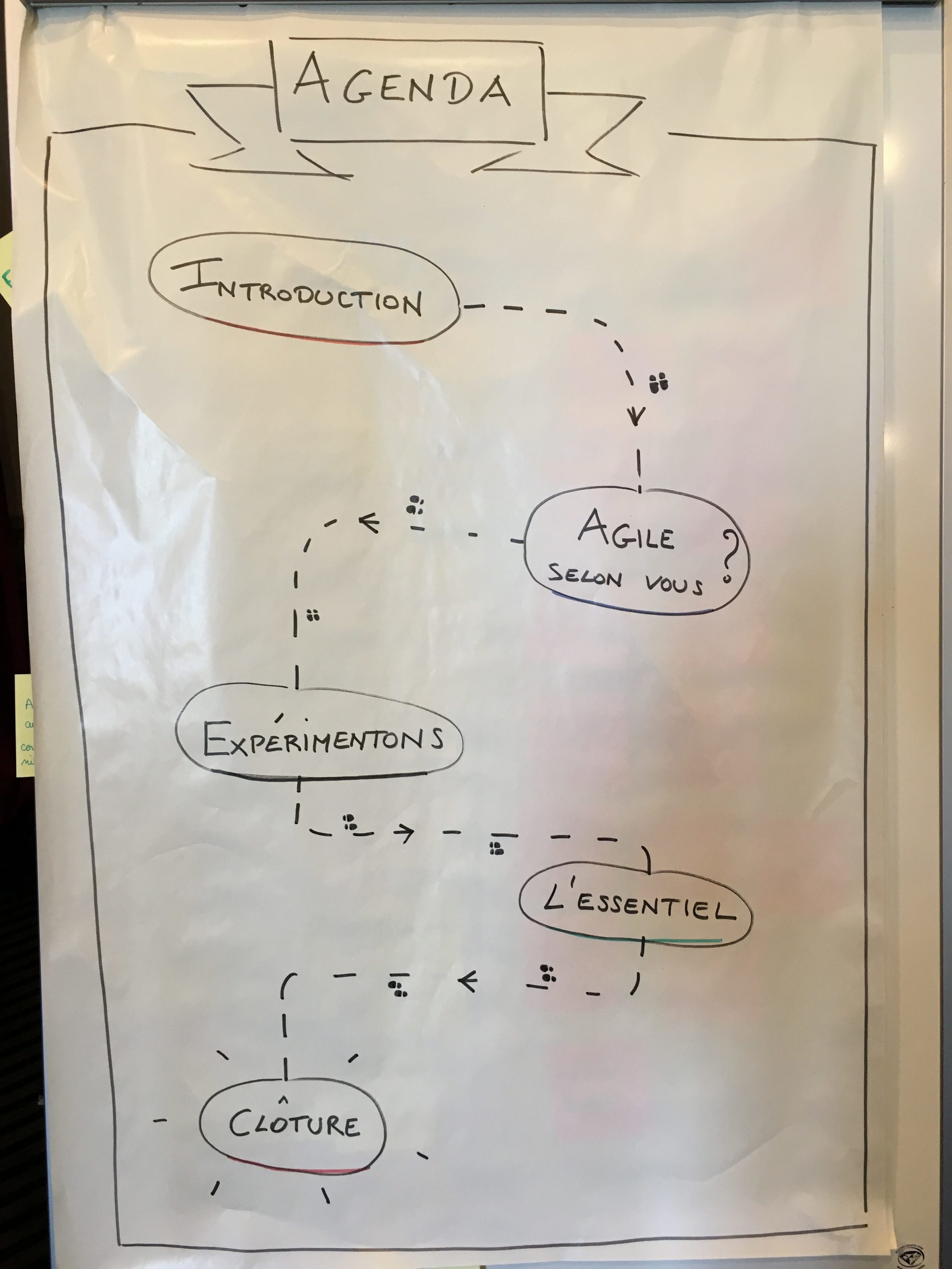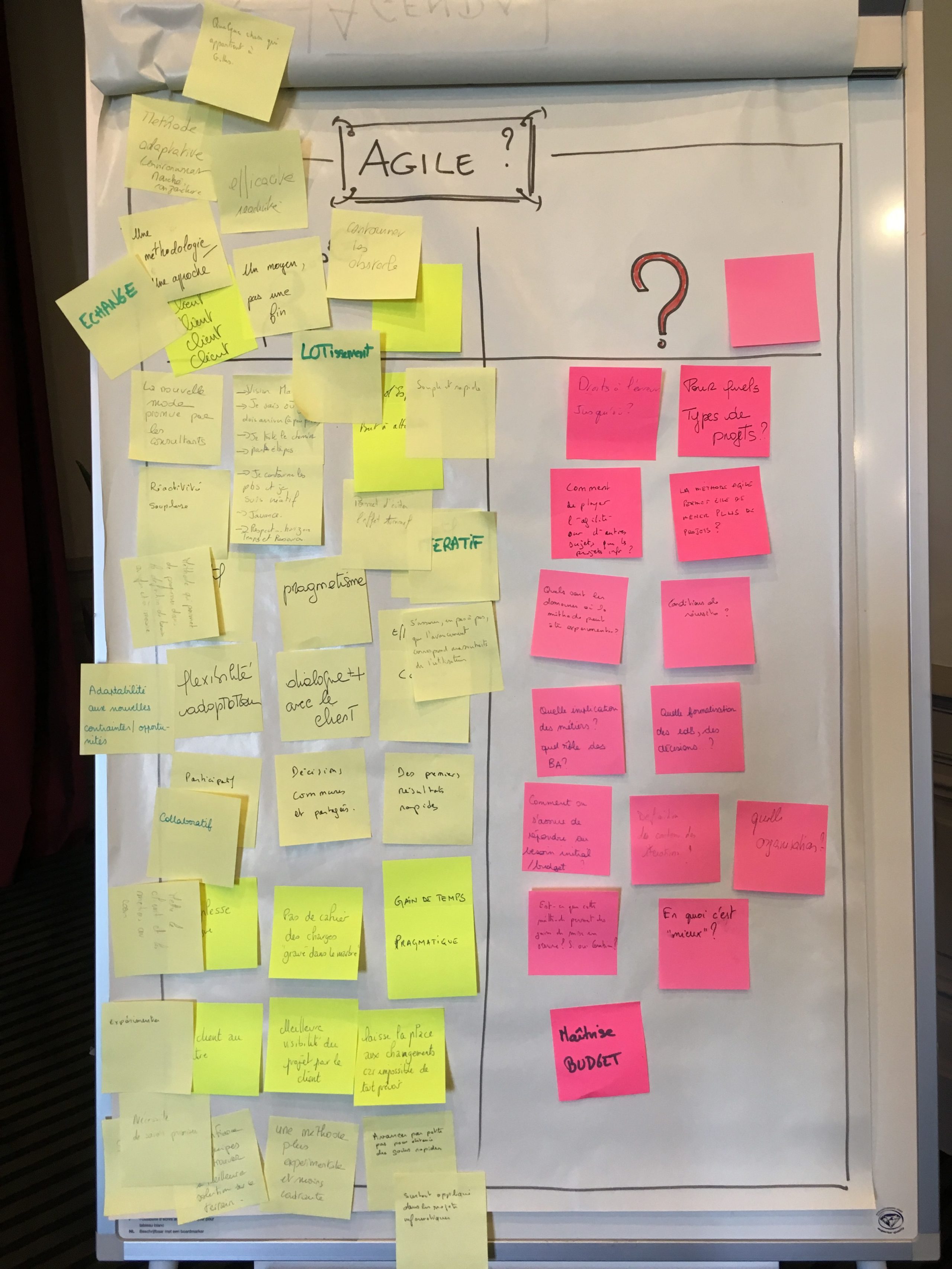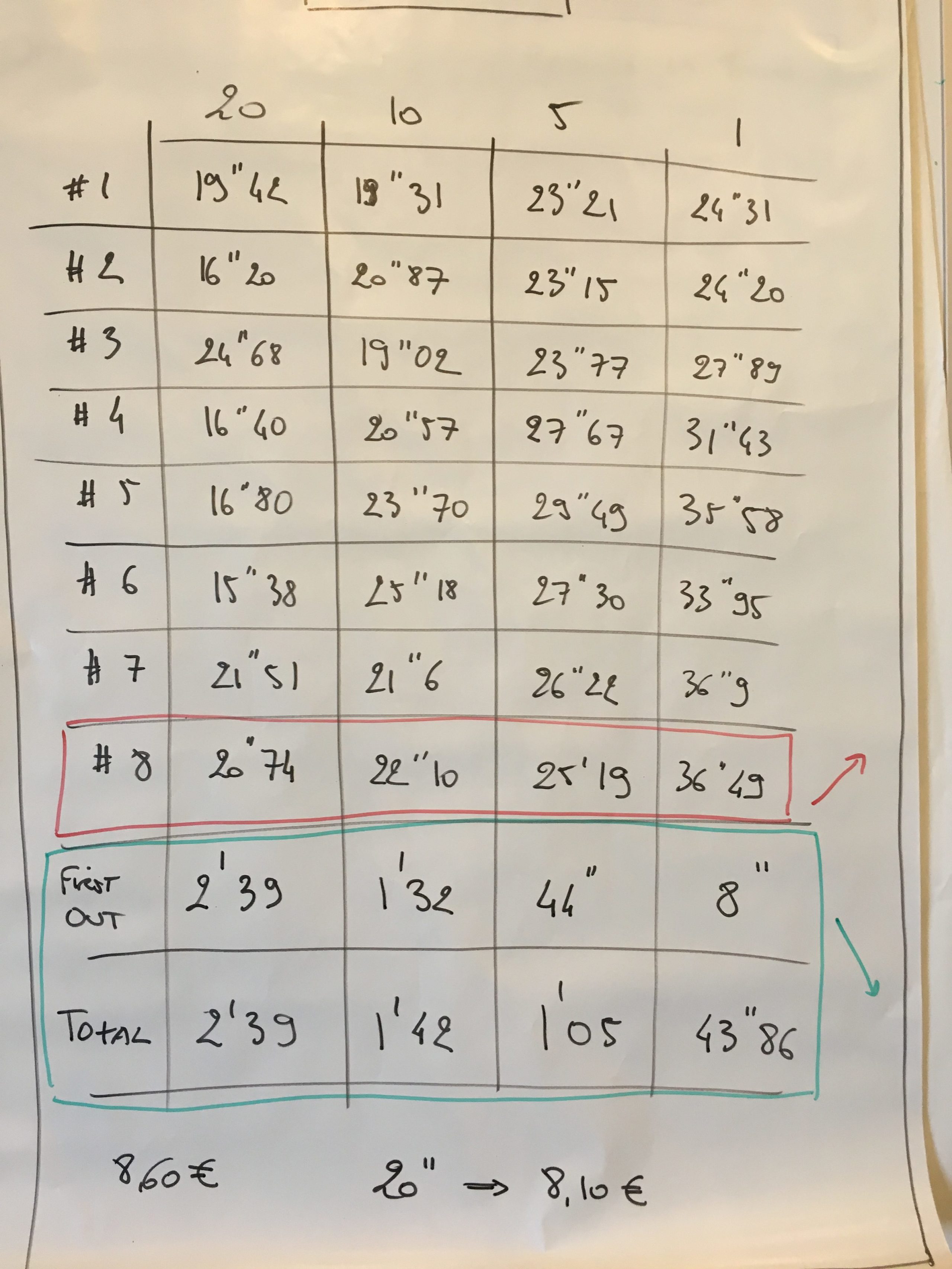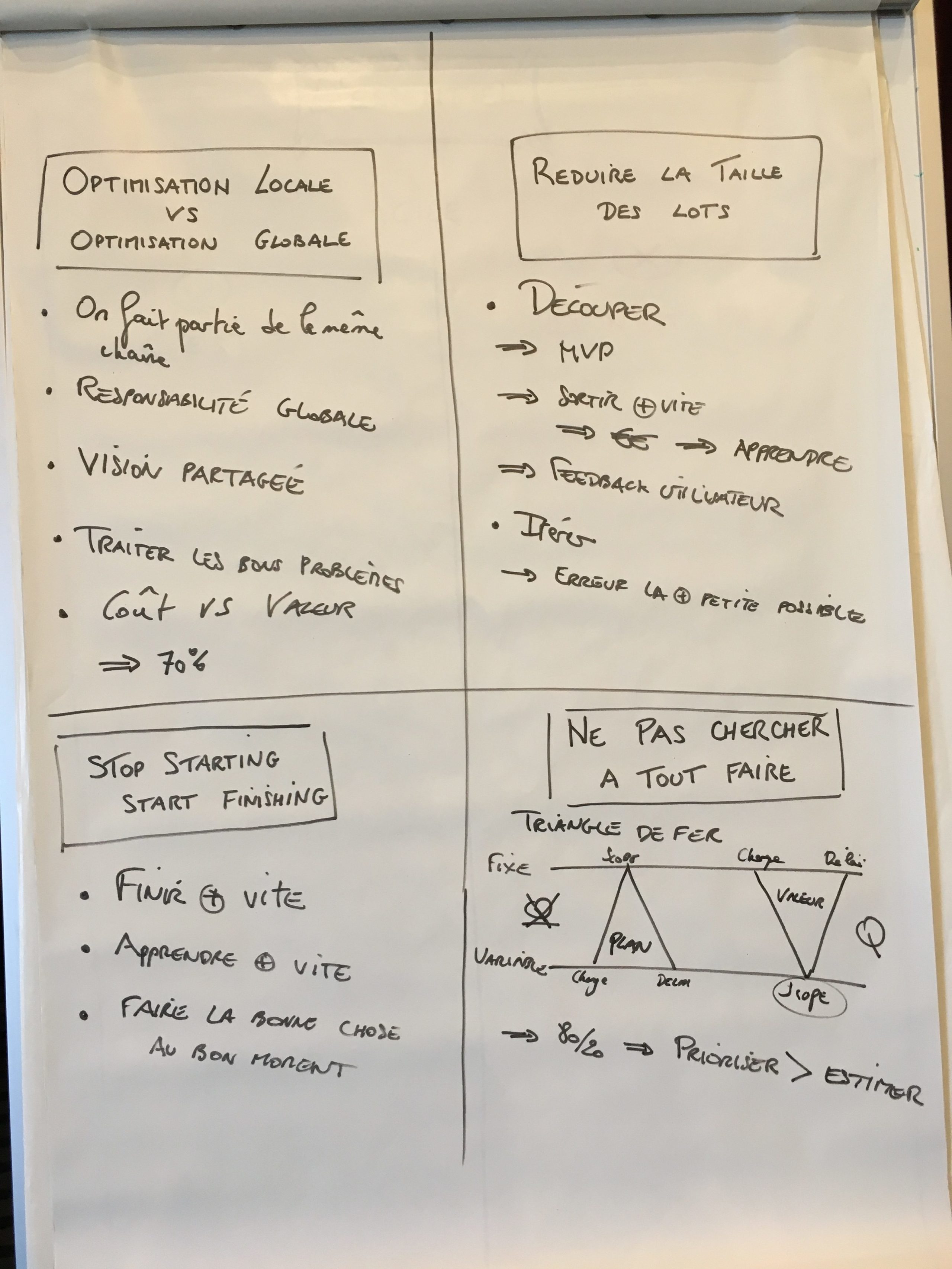
Photo by Hunters Race on Unsplash
Dans le cadre d’une de mes missions actuelles, j’ai été sollicité par mon mandataire pour parler d’Agilité lors d’un CoDir. C’était en fait une des premières fois que j’ai dû faire ce genre d’exercices : un public différent avec des attentes différentes et pourtant un sujet qui reste bel et bien le même !
Connaissant l’importance d’amener le Top Management à comprendre son rôle dans une démarche Agile, je me devais de trouver un moyen d’être impactant :
- Quels sont les messages les plus pertinents à faire passer ?
- De quelle manière ?
- Comment susciter l’intérêt, ou tout du moins, ne pas générer de levée de boucliers ?
Voici comment j’ai répondu à cette demande, de la conception au déroulé de l’atelier ! 😉
Note : promis, je n’ai pas mis de costume ! 😛
Contexte de la demande

Je vous partage ci-dessous les données brutes du contexte et de la demande que j’ai reçus :
- La demande est une « Sensibilisation à l’Agilité » de 2h qui aura lieu pendant une journée de travail du CoDir
- La maturité du CoDir à ce sujet doit être considérée à 0
- Le public formé de Directeurs, environ 15 personnes
- Le besoin est de donner des bases sur l’Agilité de manière pragmatique et opérationnelle :
- La notion de chiffrage
- Ce que l’Agilité apporte
- Ce que l’Agilité est
- Ce que l’Agilité n’est pas
- Combattre la rumeur : « Agile, ça prend moins de temps »
- Public qui considère savoir ce qu’est la Gestion de Projet et qui trouve cela chiant
- Si possible aborder des sujets comme :
- Le principe Itératif
- Les tests utilisateurs et les retours Métier : l’importance d’être au plus proche des métiers
- Faire passer le Motto : « Stop Starting, Start Finishing »
- Élargir le débat afin d’embarquer les personnes dans la démarche
- Le souhait serait que les directeurs repartent avec :
- Une meilleure compréhension de ce que veut dire le terme « Agile » comme on l’entend nous
- Une responsabilisation du métier demandeur
Une belle liste de Noël, vous ne trouvez pas ? 😛
Maintenant, voyons voir ce que l’on peut faire à partir de là ! 😉
Conception

Reprenons les éléments précédents pour en extraire les informations dont nous avons besoin :
|
Comme à mon habitude, les premières informations que je recherche concernent le cadre. En effet, la définition de ce cadre permet déjà d’avoir une idée sur ce que l’on peut se permettre de faire ou non et de réfléchir sur quelques éléments de forme.
De manière générale, j’affectionne particulièrement les ateliers dans le sens où ils sont participatifs, que le message est moins descendant – ce qui selon moi contribue donc moins au biais d’autorité – et permet d’engager les participants dans une réflexion qui leur est propre.
Timing
En 2h, il y a de quoi faire ! Maintenant il y a un certain nombre de messages à passer donc je ne peux pas me permettre de faire un atelier trop long comme un Lego4Scrum ou un getKanban. Je vais donc plutôt opter sur un ou plusieurs ateliers à durée courte ou moyenne (max 45 minutes)
Nombre de personnes
Le nombre de personnes influence de plus mon choix d’ateliers car plus il y a de personnes, plus il y a de risques de débordements en termes de temps (surtout si on fait plusieurs équipes et qu’il y a des débriefings asynchrones). Je vais plutôt opter sur un seul atelier pour prendre le temps du débriefing et pour garder de la place à un potentiel élargissement du débat.
Intention
On parle d’une sensibilisation à l’Agilité, pragmatique et opérationnelle.
Ainsi, pour être impactant, il faudrait pouvoir voir un résultat concret au bout de l’atelier. Le Penny Game est une activité que j’affectionne beaucoup et qui a justement l’intérêt de faire réfléchir par rapport à des résultats concrets car directement mesurés de l’expérience ! Elle n’est pas trop longue et rentre bien dans le timing que je souhaite et peut faire intervenir l’ensemble des participants en même temps !
Je vais également éviter de passer trop de temps sur la théorie de l’Agilité (Manifeste Agile, historique…)
Cible
La cible de cette session correspond à des directeurs avec une maturité considérée comme proche de 0, avec quelques préjugés sur l’Agilité. Rien d’inhabituel à ce stade. Cependant, leur impact sur le reste de la transformation est loin d’être négligeable : ce sont souvent eux qui exhortent les équipes à être Agile sans pour autant en comprendre la véritable teneur.
Pour voir où en sont véritablement ces directeurs, il peut être intéressant de faire émerger ce qu’ils entendent eux par le terme « Agile ». Un des intérêts est de mettre en lumière au collectif l’homogénéité ou l’hétérogénéité de perceptions à ce sujet.
Un autre intérêt pour moi est d’observer qui seront de bon alliés sur qui m’appuyer pour la suite.
A ce niveau de la réflexion, je pars avec :
- une potentielle amorce : « Que représente le terme Agile pour vous ? »
- un atelier de mise en situation : le Penny Game
A voir maintenant si au travers du Penny Game, je peux réussir à faire passer les messages nécessaires décrits dans la liste ci-dessous :
|
« Stop Starting, Start Finishing »
Le Penny Game est la plupart du temps utilisé pour parler d’optimisation globale du flux ainsi que de limitation de la taille des lots pour une meilleure productivité. Son utilisation est donc directe pour faire passer cette notion phare du Lean Kanban !
Commencer à terminer pour avoir la possibilité d’apprendre plus vite d’un contexte en changement permanent : les besoins tout comme les solutions doivent s’adapter en continu, c’est pourquoi on utilise des itérations courtes pour limiter l’impact des erreurs.
Optimisation globale vs locale
L’optimisation globale permet d’introduire le fait que les personnes font partie d’une même chaîne, la chaîne de production de valeur !
Pour aligner toutes les parties, il est nécessaire d’avoir une vision partagée avec l’ensemble des collaborateurs.
La responsabilité est donc globale et non plus locale :
- Chaque directeur n’a donc pas que son périmètre à gérer mais doit regarder si ses actions ont bien une cohérence globale sur la vision d’entreprise.
- Que je sois Métier, IT, Business Analyst, Testeur ou autre, si un problème émerge, sa résolution reste de la responsabilité de tout le monde.
Parler Priorisation pour introduire l’importance du Métier
La dernière partie du Penny game nous montre qu’il est nécessaire de ne pas tout faire si l’on souhaite garder un ratio 80/20 pertinent. Ne pas chercher à tout faire nous permet naturellement d’introduire le triangle de fer Agile impliquant le plus gros changement de paradigme.
La priorisation est donc fondamentale pour pouvoir faire la bonne chose au bon moment et ainsi focaliser nos efforts aux bons endroits. Le métier est donc nécessairement impliqué dans le processus car il est censé être au plus proche des besoins utilisateurs.
Afin de pouvoir prioriser au mieux sur la durée, il est important :
- d’obtenir du feedback au plus proche des futurs utilisateurs : on peut introduire ici la notion de tests utilisateurs
- tout en gardant une vision long terme sur les besoins exprimés : on peut introduire ici la notion de revue (en nous appuyant sur ce que Scrum propose)
Évoquer le sujet du chiffrage donc de l’estimation en Agile
Lorsque l’on évoque le triangle de fer, on met en avant que la variable d’ajustement devient le contenu et non plus le délai et la charge. Cela implique que ces derniers éléments sont fixés : on parle alors d’investissement.
Comme décrit plus longuement dans mon article « Estimation et Agilité : un paradoxe ? », le chiffrage initial est souvent utilisé comme mécanisme de prise de décision car l’on croît que l’on peut définir le résultat que l’on obtiendra à l’avance (généralement en passant du temps à l’analyse et à la planification). C’est une illusion sur laquelle beaucoup de dérives de l’Agilité sont basées en ne prenant en compte qu’un ensemble de pratiques sans pour autant changer le changement de paradigme nécessaire.
Une piste de travail est la mesure de notre capacité à produire de la valeur à un instant t pour nous donner une idée pour le futur.
Combinée à une priorisation continue, le chiffrage initial demandé aux équipes perd de sa valeur au profit d’un découpage plus fin et d’une mise à disposition rapide et fréquente aux utilisateurs de résultats concrets permettant de prendre les bonnes décisions au bon moment.
Ainsi, cela me rassure dans le fait que l’atelier me donnera l’occasion de pouvoir évoquer les sujets nécessaires à une Sensibilisation à l’Agilité ! 🙂
| Note : Il m’apparaît néanmoins important d’appuyer à nouveau sur le fait que ce n’est pas le choix de l’atelier qui prime mais plutôt l’objectif à atteindre. En effet, mieux vaut parfois utiliser un atelier que l’on maîtrise et de le réorienter dans la bonne direction (ce qui était mon cas avec le Penny Game) que d’utiliser le « bon atelier » de la mauvaise manière. |
Terminons avec les derniers éléments de la liste :
|
Pour traiter ces derniers éléments, garder un peu de temps de clôture me semble suffisant.
Proposition finale

Avec tout cela, je pense avoir ce qu’il me faut pour remplir mes 2h de manière cohérente et pertinente :
- Introduction
- « Agile » selon vous
- Le Penny Game pour parler d’Agilité
- Résumé des notions principales
- Clôture et Ouverture
Déroulement
Pour démarrer la session, il était important pour moi que mon mandataire / demandeur soit partie prenante de l’introduction.
En effet, cela permet de contextualiser mon intervention et dans le même temps, cela justifie l’intérêt à porter aux activités qui vont suivre.
Agile selon vous ?

Dans cette partie, j’ai invité les participants à réfléchir à 2 choses :
- Ce que le terme « Agile » représente pour moi (à gauche sur la photo)
- Les questionnements que j’ai à ce sujet (à droite sur la photo)
L’idée principale était de voir :
- quels étaient les préjugés grâce aux éléments de gauche
- si nous pouvions répondre aux questionnements de droite au cours de la session
Expérimentons avec le Penny Game
Je ne rentrerais pas dans les détails de l’animation de l’atelier que vous pouvez retrouver ici.
Voici néanmoins les résultats obtenus dans cette occurence :

Il était intéressant de voir que les données chiffrées emmènent à beaucoup d’échanges.
Le débriefing a principalement été effectué par les participants eux-mêmes que ce soit au niveau des interrogations que cela a pu générer mais également au niveau des réponses.
La diversité des profils a été de grand intérêt et l’on pouvait sentir l’hétérogénéité des modes de pensée par la même occasion.
Agile : l’essentiel

Pour m’assurer que les messages principaux aient été perçus par l’ensemble des participants, j’ai pris un moment pour faire un résumé des notions mises en lumière au travers de l’atelier sur un Paperboard.
Nous avons par la suite clôturé la session en ouvrant le débat sur l’éventualité d’amener de l’Agilité dans d’autres environnements que l’IT.
Conclusion

Cette animation de 2h a été plutôt bien accueillie par l’ensemble des participants. Elle a été génératrice d’échanges et de curiosité dépassant la sphère de l’IT ce qui est pour moi un bel indicateur de succès. Pour ma part, ce fut un beau challenge à relever dans le sens où l’importance des mots employés, des thèmes abordés et de la manière de les introduire était très grande.
Bien sûr, ce n’est qu’une manière de faire parmi d’autres, j’espère néanmoins que celle-ci pourra vous inspirer !
D’ailleurs, je serais curieux de savoir comment vous approchez de votre côté ce type d’intervention !
N’hésitez pas à me les partager 😉







Une réponse
BONJOUR
JE TROUVE LE TOPO BIEN CONÇU ET REPRESENTATIF DE L ETAT D ESPRIT A FAIRE PASSER
JE SUIS ENSEIGNANT EN IAE ET CELA POURRA M AIDER A FAIRE PASSER LE MESSAGE
CLDT